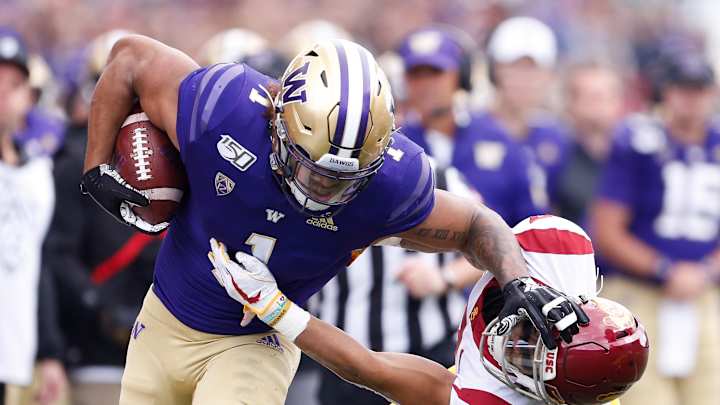Making Sense of a Disastrous NFL Draft for the Huskies

The Washington Huskies in recent years churned out NFL draft picks similar to Clemson, Ohio State and Alabama. Their latest draft class had promising prospects topped by prototypical pocket passer Jacob Eason, made-to-order blindside tackle Trey Adams, speedy tailback Salvon Ahmed and mismatch tight end Hunter Bryant.
The NFL also took a look at undersized center Nick Harris and liked what it saw.
Something happened between the Las Vegas Bowl and the NFL Combine -- something disastrous. These Huskies were shown to have no speed.
The situation happened last year with Myles Gaskin. Photos circulated of him bulked up with bulging biceps and ripped abs. His pre-combine before and after photo comparison was impressive.
His 40 time wasn't.
He was slower than advertised.
The NFL will take chances on undersized guys who are fast, work hard and prove to be smart. There are tons of examples. The league won't gamble on guys who are slow in positions where speed is a necessity. They'll use free-agency funds but not draft dollars.
Salvon Ahmed, and Hunter Bryant left school early and were prepared to cash in until the NFL Combine raised red flags.
Dawgs in Indy.
— Washington Football (@UW_Football) March 2, 2020
Nick Harris.
Trey Adams.
Salvon Ahmed.
Myles Bryant. #PurpleReign x #NFLCombine pic.twitter.com/E1pJdccOco
Prior to the combine, Ahmed's best 40 time was 4.32 seconds recorded at the Husky Combine. It was a trusted time, given that former UW coach Chris Petersen was in charge.
⭐️FSP Draft Class 2020⭐️
— Tracy Ford (@TFordFSP) February 28, 2020
🔥Athlete: Salvon Ahmed (@AhmedSalvon )
✅Before: 190lb/ 13.5% bdy fat
✅After 197/ 8.2 % Bdy fat
📝 7 weeks of grinding and sacrifice pic.twitter.com/4FfquYoMOK
As seen in the above tweet, Ahmed dropped his body mass index from 13.5 percent to 8.2 while increasing his weight from 191 pounds to 197.
Bigger, faster, stronger? Yes, no, yes.
Detroit lands PFF's TE1, Hunter Bryant.
— PFF College (@PFF_College) April 26, 2020
Bryant had the most yards per route run in the PFF College era. pic.twitter.com/QnrVQzxcQP
"When he was at Washington, Hunter Bryant was a physical specimen," Husky Maven/Sports Illustrated's Trevor Mueller said. "He was too fast for a linebacker, too physical for a defensive back."
He was a mismatch for opponents and it was his quarterback's job to find him and recognize a favorable matchup. And he did.
Bryant dropped one Jake Browning pass in two years before failing to hang onto eight or nine balls from Eason. Despite his uptick in drops this season, according to Pro Football Focus, "Bryant had the most yards per route run in the PFF College era."
The knock on Hunter was that he was injury-prone his first two years. However, he played in all 12 of Washington games this past season. That checks that box.
Somehow Bryant's 40-time went bad. From an expected 4.5 seconds, he clocked in at 4.74. Bryant expected to turn heads with his combine 40-yard dash but it didn't happen.
Hunter's season playing weight was 239 pounds but was up to 248 at the combine.
Rewind to 2019 when UW's Kaleb McGary backed up a strong combine performance with a stellar Washington Pro Day and upped his pro stock. The Atlanta Falcons were so impressed they traded up to the first round to nab the Morris Trophy winner.
Gaskin, on the other hand, surprised many last year with a NFL Combine 40 time of 4.58 seconds. He was expected to be in the 4.4-4.5 range, not a shade under 4.6 seconds. Gaskin did 24 bench-press reps of 225 pounds. However, he tipped the scales at 205 pounds and clearly was a step slower in Indianapolis.
Once back in Seattle, Gaskin dropped the extra weight to get his speed back. By the time UW's Pro Day rolled around, he was back in the football playing shape that enabled him to churn out over 5,300 yards in his career.
Nick Harris, an afterthought in Washington's 2016 recruiting class, went to the Cleveland Browns in the fifth round. Somewhat undersized by NFL standards, he put his speed and athleticism on display in Indy and he didn't need to show scouts anything else.
Trey Adams, Ahmed, and Bryant had no Pro Day to demonstrate why they received a combine invitation in the first place. The lasting impression they left on the NFL scouts had was their first. They received no second chances.
